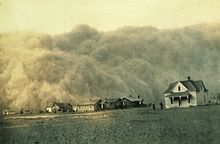Sources
Main article: AP 42 Compilation of Air Pollutant Emission Factors
Dust storm approaching Stratford, Texas
Controlled burning of a field outside of Statesboro, Georgia in preparation for spring planting
Anthropogenic sources (human activity) mostly related to burning different kinds of fuel
- "Stationary Sources" include smoke stacks of power plants, manufacturing facilities (factories) and waste incinerators, as well as furnaces and other types of fuel-burning heating devices
- "Mobile Sources" include motor vehicles, marine vessels, aircraft and the effect of sound etc.
- Chemicals, dust and controlled burn practices in agriculture and forestry management. Controlled or prescribed burning is a technique sometimes used in forest management, farming, prairie restoration or greenhouse gas abatement. Fire is a natural part of both forest and grassland ecology and controlled fire can be a tool for foresters. Controlled burning stimulates the germination of some desirable forest trees, thus renewing the forest.
- Fumes from paint, hair spray, varnish, aerosol sprays and other solvents
- Waste deposition in landfills, which generate methane. Methane is not toxic; however, it is highly flammable and may form explosive mixtures with air. Methane is also an asphyxiant and may displace oxygen in an enclosed space. Asphyxia or suffocation may result if the oxygen concentration is reduced to below 19.5% by displacement
- Military, such as nuclear weapons, toxic gases, germ warfare and rocketry


No comments:
Post a Comment